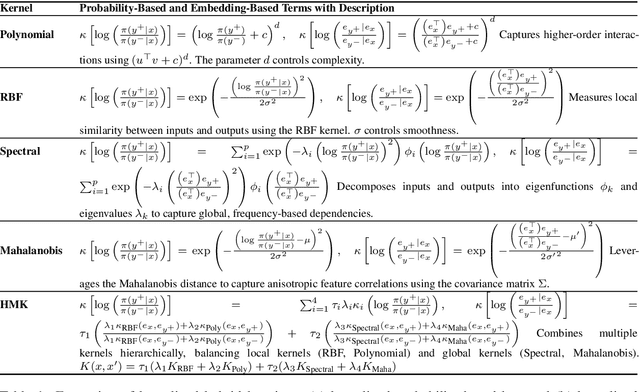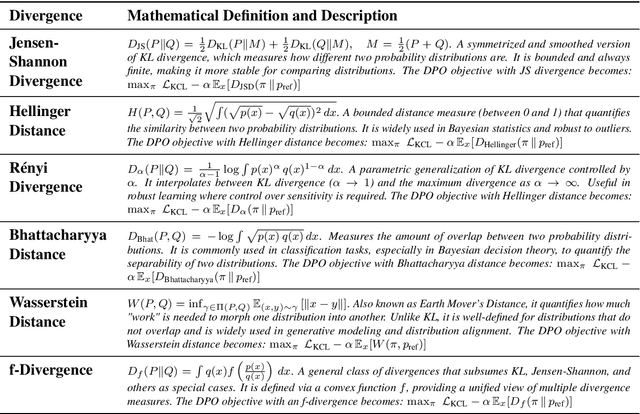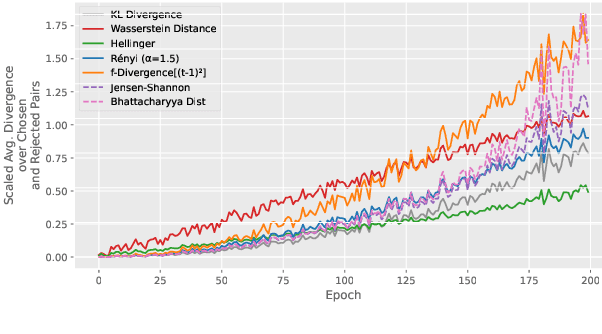Aman Chadha
AdversariaL attacK sAfety aLIgnment(ALKALI): Safeguarding LLMs through GRACE: Geometric Representation-Aware Contrastive Enhancement- Introducing Adversarial Vulnerability Quality Index (AVQI)
Jun 11, 2025Abstract:Adversarial threats against LLMs are escalating faster than current defenses can adapt. We expose a critical geometric blind spot in alignment: adversarial prompts exploit latent camouflage, embedding perilously close to the safe representation manifold while encoding unsafe intent thereby evading surface level defenses like Direct Preference Optimization (DPO), which remain blind to the latent geometry. We introduce ALKALI, the first rigorously curated adversarial benchmark and the most comprehensive to date spanning 9,000 prompts across three macro categories, six subtypes, and fifteen attack families. Evaluation of 21 leading LLMs reveals alarmingly high Attack Success Rates (ASRs) across both open and closed source models, exposing an underlying vulnerability we term latent camouflage, a structural blind spot where adversarial completions mimic the latent geometry of safe ones. To mitigate this vulnerability, we introduce GRACE - Geometric Representation Aware Contrastive Enhancement, an alignment framework coupling preference learning with latent space regularization. GRACE enforces two constraints: latent separation between safe and adversarial completions, and adversarial cohesion among unsafe and jailbreak behaviors. These operate over layerwise pooled embeddings guided by a learned attention profile, reshaping internal geometry without modifying the base model, and achieve up to 39% ASR reduction. Moreover, we introduce AVQI, a geometry aware metric that quantifies latent alignment failure via cluster separation and compactness. AVQI reveals when unsafe completions mimic the geometry of safe ones, offering a principled lens into how models internally encode safety. We make the code publicly available at https://anonymous.4open.science/r/alkali-B416/README.md.
Can Large Language Models Infer Causal Relationships from Real-World Text?
May 25, 2025Abstract:Understanding and inferring causal relationships from texts is a core aspect of human cognition and is essential for advancing large language models (LLMs) towards artificial general intelligence. Existing work primarily focuses on synthetically generated texts which involve simple causal relationships explicitly mentioned in the text. This fails to reflect the complexities of real-world tasks. In this paper, we investigate whether LLMs are capable of inferring causal relationships from real-world texts. We develop a benchmark drawn from real-world academic literature which includes diverse texts with respect to length, complexity of relationships (different levels of explicitness, number of events, and causal relationships), and domains and sub-domains. To the best of our knowledge, our benchmark is the first-ever real-world dataset for this task. Our experiments on state-of-the-art LLMs evaluated on our proposed benchmark demonstrate significant challenges, with the best-performing model achieving an average F1 score of only 0.477. Analysis reveals common pitfalls: difficulty with implicitly stated information, in distinguishing relevant causal factors from surrounding contextual details, and with connecting causally relevant information spread across lengthy textual passages. By systematically characterizing these deficiencies, our benchmark offers targeted insights for further research into advancing LLM causal reasoning.
Just as Humans Need Vaccines, So Do Models: Model Immunization to Combat Falsehoods
May 23, 2025Abstract:Generative AI models often learn and reproduce false information present in their training corpora. This position paper argues that, analogous to biological immunization, where controlled exposure to a weakened pathogen builds immunity, AI models should be fine tuned on small, quarantined sets of explicitly labeled falsehoods as a "vaccine" against misinformation. These curated false examples are periodically injected during finetuning, strengthening the model ability to recognize and reject misleading claims while preserving accuracy on truthful inputs. An illustrative case study shows that immunized models generate substantially less misinformation than baselines. To our knowledge, this is the first training framework that treats fact checked falsehoods themselves as a supervised vaccine, rather than relying on input perturbations or generic human feedback signals, to harden models against future misinformation. We also outline ethical safeguards and governance controls to ensure the safe use of false data. Model immunization offers a proactive paradigm for aligning AI systems with factuality.
LoRACode: LoRA Adapters for Code Embeddings
Mar 07, 2025Abstract:Code embeddings are essential for semantic code search; however, current approaches often struggle to capture the precise syntactic and contextual nuances inherent in code. Open-source models such as CodeBERT and UniXcoder exhibit limitations in scalability and efficiency, while high-performing proprietary systems impose substantial computational costs. We introduce a parameter-efficient fine-tuning method based on Low-Rank Adaptation (LoRA) to construct task-specific adapters for code retrieval. Our approach reduces the number of trainable parameters to less than two percent of the base model, enabling rapid fine-tuning on extensive code corpora (2 million samples in 25 minutes on two H100 GPUs). Experiments demonstrate an increase of up to 9.1% in Mean Reciprocal Rank (MRR) for Code2Code search, and up to 86.69% for Text2Code search tasks across multiple programming languages. Distinction in task-wise and language-wise adaptation helps explore the sensitivity of code retrieval for syntactical and linguistic variations.
YINYANG-ALIGN: Benchmarking Contradictory Objectives and Proposing Multi-Objective Optimization based DPO for Text-to-Image Alignment
Feb 05, 2025Abstract:Precise alignment in Text-to-Image (T2I) systems is crucial to ensure that generated visuals not only accurately encapsulate user intents but also conform to stringent ethical and aesthetic benchmarks. Incidents like the Google Gemini fiasco, where misaligned outputs triggered significant public backlash, underscore the critical need for robust alignment mechanisms. In contrast, Large Language Models (LLMs) have achieved notable success in alignment. Building on these advancements, researchers are eager to apply similar alignment techniques, such as Direct Preference Optimization (DPO), to T2I systems to enhance image generation fidelity and reliability. We present YinYangAlign, an advanced benchmarking framework that systematically quantifies the alignment fidelity of T2I systems, addressing six fundamental and inherently contradictory design objectives. Each pair represents fundamental tensions in image generation, such as balancing adherence to user prompts with creative modifications or maintaining diversity alongside visual coherence. YinYangAlign includes detailed axiom datasets featuring human prompts, aligned (chosen) responses, misaligned (rejected) AI-generated outputs, and explanations of the underlying contradictions.
From Fog to Failure: How Dehazing Can Harm Clear Image Object Detection
Feb 04, 2025



Abstract:This study explores the challenges of integrating human visual cue-based dehazing into object detection, given the selective nature of human perception. While human vision adapts dynamically to environmental conditions, computational dehazing does not always enhance detection uniformly. We propose a multi-stage framework where a lightweight detector identifies regions of interest (RoIs), which are then enhanced via spatial attention-based dehazing before final detection by a heavier model. Though effective in foggy conditions, this approach unexpectedly degrades the performance on clear images. We analyze this phenomenon, investigate possible causes, and offer insights for designing hybrid pipelines that balance enhancement and detection. Our findings highlight the need for selective preprocessing and challenge assumptions about universal benefits from cascading transformations.
IndicMMLU-Pro: Benchmarking the Indic Large Language Models
Jan 27, 2025Abstract:Known by more than 1.5 billion people in the Indian subcontinent, Indic languages present unique challenges and opportunities for natural language processing (NLP) research due to their rich cultural heritage, linguistic diversity, and complex structures. IndicMMLU-Pro is a comprehensive benchmark designed to evaluate Large Language Models (LLMs) across Indic languages, building upon the MMLU Pro (Massive Multitask Language Understanding) framework. Covering major languages such as Hindi, Bengali, Gujarati, Marathi, Kannada, Punjabi, Tamil, Telugu, and Urdu, our benchmark addresses the unique challenges and opportunities presented by the linguistic diversity of the Indian subcontinent. This benchmark encompasses a wide range of tasks in language comprehension, reasoning, and generation, meticulously crafted to capture the intricacies of Indian languages. IndicMMLU-Pro provides a standardized evaluation framework to push the research boundaries in Indic language AI, facilitating the development of more accurate, efficient, and culturally sensitive models. This paper outlines the benchmarks' design principles, task taxonomy, data collection methodology, and presents baseline results from state-of-the-art multilingual models.
Potential and Perils of Large Language Models as Judges of Unstructured Textual Data
Jan 14, 2025
Abstract:Rapid advancements in large language models have unlocked remarkable capabilities when it comes to processing and summarizing unstructured text data. This has implications for the analysis of rich, open-ended datasets, such as survey responses, where LLMs hold the promise of efficiently distilling key themes and sentiments. However, as organizations increasingly turn to these powerful AI systems to make sense of textual feedback, a critical question arises, can we trust LLMs to accurately represent the perspectives contained within these text based datasets? While LLMs excel at generating human-like summaries, there is a risk that their outputs may inadvertently diverge from the true substance of the original responses. Discrepancies between the LLM-generated outputs and the actual themes present in the data could lead to flawed decision-making, with far-reaching consequences for organizations. This research investigates the effectiveness of LLMs as judge models to evaluate the thematic alignment of summaries generated by other LLMs. We utilized an Anthropic Claude model to generate thematic summaries from open-ended survey responses, with Amazon's Titan Express, Nova Pro, and Meta's Llama serving as LLM judges. The LLM-as-judge approach was compared to human evaluations using Cohen's kappa, Spearman's rho, and Krippendorff's alpha, validating a scalable alternative to traditional human centric evaluation methods. Our findings reveal that while LLMs as judges offer a scalable solution comparable to human raters, humans may still excel at detecting subtle, context-specific nuances. This research contributes to the growing body of knowledge on AI assisted text analysis. We discuss limitations and provide recommendations for future research, emphasizing the need for careful consideration when generalizing LLM judge models across various contexts and use cases.
DPO Kernels: A Semantically-Aware, Kernel-Enhanced, and Divergence-Rich Paradigm for Direct Preference Optimization
Jan 08, 2025



Abstract:The rapid rise of large language models (LLMs) has unlocked many applications but also underscores the challenge of aligning them with diverse values and preferences. Direct Preference Optimization (DPO) is central to alignment but constrained by fixed divergences and limited feature transformations. We propose DPO-Kernels, which integrates kernel methods to address these issues through four key contributions: (i) Kernelized Representations with polynomial, RBF, Mahalanobis, and spectral kernels for richer transformations, plus a hybrid loss combining embedding-based and probability-based objectives; (ii) Divergence Alternatives (Jensen-Shannon, Hellinger, Renyi, Bhattacharyya, Wasserstein, and f-divergences) for greater stability; (iii) Data-Driven Selection metrics that automatically choose the best kernel-divergence pair; and (iv) a Hierarchical Mixture of Kernels for both local precision and global modeling. Evaluations on 12 datasets demonstrate state-of-the-art performance in factuality, safety, reasoning, and instruction following. Grounded in Heavy-Tailed Self-Regularization, DPO-Kernels maintains robust generalization for LLMs, offering a comprehensive resource for further alignment research.
LLMsAgainstHate @ NLU of Devanagari Script Languages 2025: Hate Speech Detection and Target Identification in Devanagari Languages via Parameter Efficient Fine-Tuning of LLMs
Dec 26, 2024Abstract:The detection of hate speech has become increasingly important in combating online hostility and its real-world consequences. Despite recent advancements, there is limited research addressing hate speech detection in Devanagari-scripted languages, where resources and tools are scarce. While large language models (LLMs) have shown promise in language-related tasks, traditional fine-tuning approaches are often infeasible given the size of the models. In this paper, we propose a Parameter Efficient Fine tuning (PEFT) based solution for hate speech detection and target identification. We evaluate multiple LLMs on the Devanagari dataset provided by (Thapa et al., 2025), which contains annotated instances in 2 languages - Hindi and Nepali. The results demonstrate the efficacy of our approach in handling Devanagari-scripted content.
 Add to Chrome
Add to Chrome Add to Firefox
Add to Firefox Add to Edge
Add to Edge